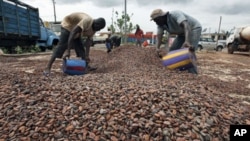Valentine’s Day is Tuesday, Feb. 14, a day when millions of people in the U.S. like to buy sweets for their sweethearts.
This year, they’re expected to spend more than $1 billion on Valentine’s candies - mostly chocolate candies, according to the National Confectioners Association.
Year-round, chocolate sales are worth more than $18 billion. It’s one of Americans’ favorite indulgences. But the chocolate industry is worried this little pleasure could get more costly in the years ahead.
Keeping the cost reasonable is the key to success for the companies that make chocolate bars.
“They’re very aware that an everyday candy product needs to be an affordable treat,” said Susan Smith, spokeswoman for the National Confectioners Association.
But keeping chocolate affordable may be a challenge in the years to come. Demand is growing, especially as emerging middle classes in Asia discover the delights of chocolate. But the industry is worried supply will not keep up.
Cocoa is the main ingredient in chocolate. And about 70 percent of the world’s cocoa is grown in West Africa by millions of poor farmers, each with just a few hectares of land.
“And they don’t have a lot of additional capital. They may not have the management skills to actually do a better job,” said Lyndel Meinhardt, who heads cocoa research at the U.S. Department of Agriculture.
According to Meinhardt, these small-scale farmers often do not have the money to buy fertilizers that would boost their productivity.
And when the land is exhausted, farmers just clear more, according to Sona Ebai, senior technical advisor with the World Cocoa Foundation.
“We end up moving from one plot to the other, encroaching on forest reserves,” said Ebai.
Deforestation in West Africa is largely driven by slash-and-burn agriculture for cocoa and other crops.
And it’s not just economics working against cocoa farmers. Ebai said farmers have to contend with cocoa’s many natural enemies.
“Just as much as we humans love cocoa and cocoa products like chocolate, it also happens that cocoa is also loved by a variety of pests and diseases,” said Ebai.
Experts say pests and diseases claim 30 percent to 40 percent of the world’s cocoa crop each year.
The chocolate industry needs farmers to produce more to meet growing demand. Small-scale farmers need help to increase their productivity and lift themselves out of poverty, without destroying more rainforest. And West African governments want to help a sector that provides $8 billion in revenues. Ebai said that provides a rare opportunity.
“For the first time, farmers, processors, chocolate multinationals, civil society are working to make sure that the cocoa economy in the world is sustainable, everybody chipping in to make it stay that way.”
Everybody from chocolate giants like Mars and Nestlé to the U.S. Agency for International Development, and the Bill and Melinda Gates Foundation is contributing millions of dollars to boost the productivity of West African cocoa farmers.
The goal is triply sweet: improving livelihoods, protecting the environment, and keeping chocolate candies affordable.








